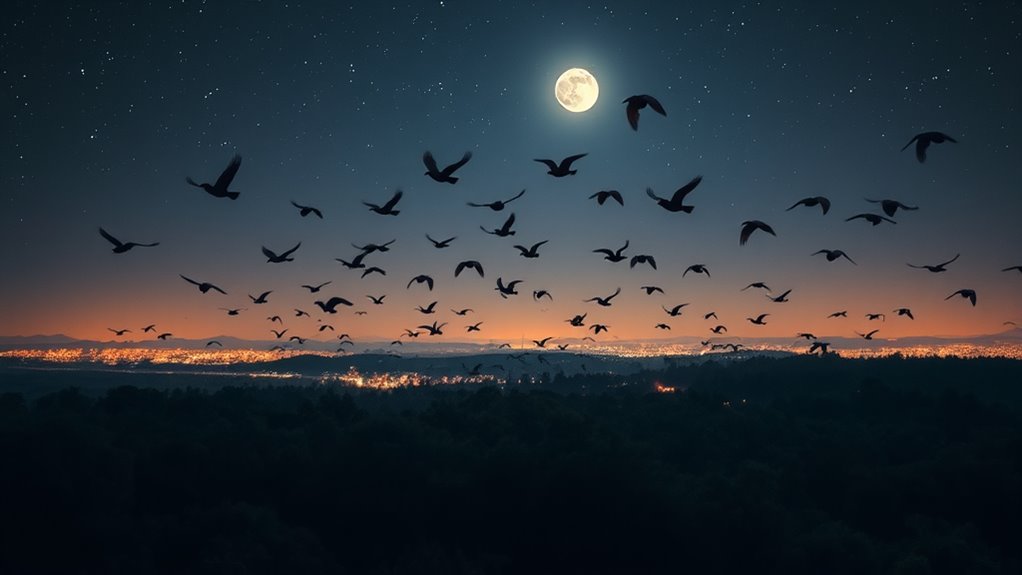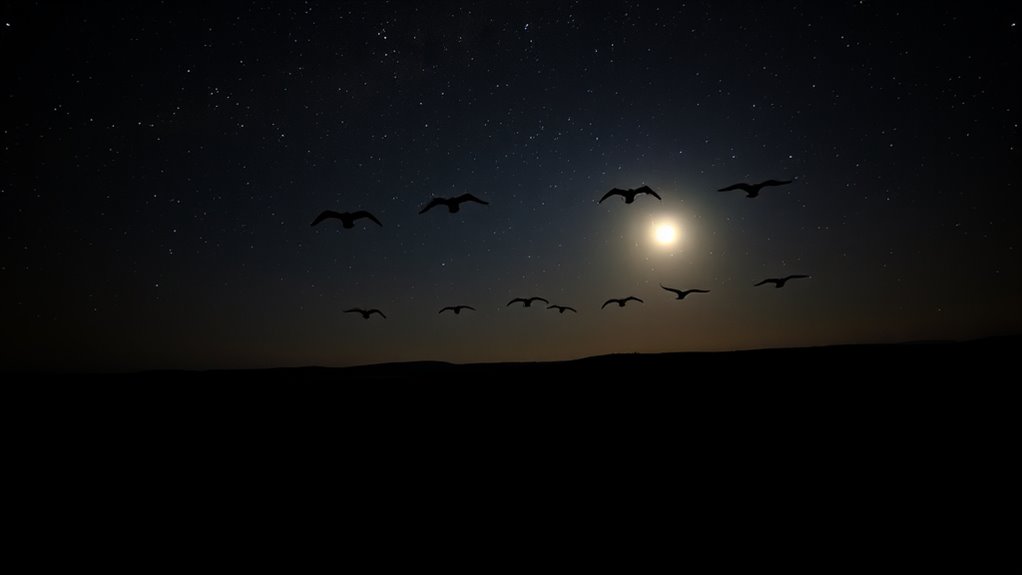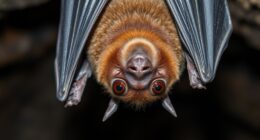Birds migrate at night mainly to avoid predators like hawks that hunt during the day. The cooler temperatures at night help them conserve energy and stay comfortable, allowing longer flights. They also use stars and the Earth's magnetic field to navigate more effectively in darkness. Flocking together during migration enhances safety and helps young birds learn routes from older ones. There's so much more to explore about these fascinating migratory strategies!
Key Takeaways
- Night migration reduces predation risks from daytime hunters, enhancing survival chances for birds.
- Cooler nighttime temperatures conserve energy, allowing for longer migrations without fatigue.
- Stars and the Earth's magnetic field assist birds in navigation, improving accuracy during night flights.
- Flocking behavior during migration increases safety and efficiency, with young birds learning from experienced adults.
- Weather conditions like clear skies and favorable winds influence the timing of nocturnal migrations.
Safety in Darkness

When birds migrate at night, they greatly boost their chances of survival by avoiding daytime predators. The darkness provides a safer environment, allowing them to navigate without the threat of hawks or other hunters.
Additionally, the cooler temperatures help prevent overheating during their long flights, allowing them to maintain their energy levels. Stars and the moon act as natural navigational aids, guiding you through the night sky.
Many migratory birds have even adapted their vision to thrive in low-light conditions, making it easier for them to spot obstacles along their route.
Energy Conservation

When birds migrate at night, they effectively reduce energy expenditure by taking advantage of cooler temperatures and ideal thermals.
This nighttime flight also helps them avoid daytime predators, allowing them to focus on efficient travel.
Reduced Energy Expenditure
Nighttime migration greatly reduces energy expenditure for birds, as cooler temperatures help prevent overheating during flight.
By flying at night, you can avoid stronger winds and thermal currents that are more common during the day, making your journey more energy-efficient.
Many migratory birds skillfully navigate using celestial cues like stars, allowing you to maintain a steady course without wasting energy on erratic movements.
Plus, migrating at night lowers your chances of encountering predators, helping you conserve energy that would otherwise go into evasive maneuvers.
This ability to travel long distances overnight means you can cover significant ground with less fatigue, allowing you to rest and feed during the day while continuing your migration journey.
Optimal Thermals Utilization
By migrating at night, birds not only reduce energy expenditure but also capitalize on ideal thermals. The cooler nighttime temperatures help lower their metabolic rates and minimize water loss, making long flights more manageable.
During these hours, birds can harness rising columns of warm air, which provide essential lift and greatly enhance their flight efficiency. Studies indicate that flying at night allows them to maintain a steadier course, free from the strong winds that often disrupt daytime migration.
In fact, specific species can boost their efficiency by up to 50% when utilizing these nighttime thermals. This strategic advantage not only aids in conserving energy but also supports their overall survival during extensive migrations.
Avoiding Daytime Predators
As birds take to the skies under the cover of darkness, they cleverly evade daytime predators like hawks and falcons that thrive in the light. By migrating at night, you'll notice they greatly reduce their risk of being spotted and hunted.
Many songbirds have evolved this behavior, taking advantage of the safety that darkness provides. The cooler nighttime temperatures also help them conserve energy, preventing overheating during long flights.
Plus, migrating at night means they can harness calm winds and stable atmospheric conditions, further conserving energy. Research shows that species like the Blackpoll Warbler can travel vast distances efficiently while minimizing exposure to predation.
This strategy not only boosts their survival rates but makes their journey much more manageable.
Navigational Aids

When you think about how birds navigate at night, it's fascinating to realize they rely on the stars and moon for guidance.
They also tap into the Earth's magnetic field, using it as a compass to stay on course.
These natural aids are essential for their long journeys across dark skies.
Stars and Celestial Navigation
Though many birds migrate during the day, those that take to the skies at night often rely on the stars for navigation. You might be surprised to learn that many migratory birds can recognize constellations and use the positions of celestial bodies to chart their flight paths.
Young birds begin learning this skill early, refining it as they grow more experienced during migrations. For example, the Indigo Bunting can adjust its flight direction based on the stars' angle relative to its location.
This remarkable ability isn't just a quirk; it's an evolutionary adaptation that helps birds avoid predators and benefit from cooler temperatures. By trusting the stars, these nocturnal travelers navigate the vast night sky with impressive accuracy.
Earth's Magnetic Field
Earth's magnetic field acts like an invisible map for migrating birds, guiding them on their long journeys. These feathered navigators use specialized cells in their eyes or magnetite-based receptors in their beaks to detect magnetic variations. This ability is essential for maintaining orientation during long flights.
Research shows that birds possess a protein called cryptochrome, helping them perceive magnetic fields through light-sensitive pathways. They often combine this magnetic sense with cues from the sun and stars to improve their navigation.
| Navigational Aid | Function |
|---|---|
| Magnetic Field | Provides orientation and direction |
| Cryptochrome Protein | Enhances magnetic perception |
| Sun and Stars | Offers additional navigational cues |
Changes in the magnetic field can also alter their migratory paths.
Optimal Flight Conditions

Flying at night offers birds a unique advantage regarding ideal flight conditions. The cooler temperatures at night help them avoid overheating during long migrations, making their journey more comfortable.
You'll notice that with less strong winds, flight becomes more stable and favorable, allowing for smoother travel over vast distances.
Plus, the absence of daylight means birds can rely on celestial navigation, using the stars and moon to guide their path. This nighttime migration not only enhances their orientation but also helps conserve energy, as cooler air can lower their metabolic rates.
Predator Avoidance Strategies

As night falls, many songbirds take advantage of the darkness to reduce their risk of predation. By migrating at night, you're avoiding the watchful eyes of diurnal predators like hawks and eagles, which hunt during the day.
The cooler temperatures and calmer winds of nighttime also enhance your survival chances. Plus, moving under the cover of darkness means you're less likely to be spotted by ground-based threats such as cats and snakes.
Some species, like the Common Nighthawk, even have camouflage plumage that helps them blend into the night sky. Using stars and moonlight for navigation not only guides your journey but keeps you less visible to potential dangers lurking in the darkness.
Social Behavior During Migration

While traversing the night skies, songbirds often form flocks, enhancing their safety and social bonds. These vocalizations help maintain group cohesion, allowing you to navigate more effectively.
You might notice some species forming mixed-species flocks—this strategy improves foraging efficiency and boosts survival rates. Social interactions play an essential role in shaping your migratory experience; they can influence your timing and routes as you adjust movements based on group dynamics and environmental cues.
If you're a young songbird, you'll likely learn critical migratory routes and behaviors from experienced adults in your social group, emphasizing the importance of social learning during migration.
Impact on Migration Patterns

Social interactions during migration not only enhance safety but also greatly influence the patterns of movement among songbirds.
Many songbirds, like warblers and thrushes, migrate at night, taking advantage of cooler temperatures and lower predation risks. This nocturnal behavior improves their chances of survival on long journeys. By guiding themselves using the stars and the Earth's magnetic field, these birds maintain accurate migratory routes.
For instance, the Blackpoll Warbler can cover thousands of miles non-stop during nighttime migrations, showcasing remarkable endurance.
Additionally, environmental factors, like weather conditions, play a significant role in migration timing. When winds are favorable and skies are clear, you'll notice an uptick in songbirds taking flight, further shaping their migration patterns.
Frequently Asked Questions
Why Are Birds Flying Around at Night?
You might notice birds flying around at night, and it's often because they're active during those hours.
Many birds, especially migratory species, take advantage of the cooler temperatures and calmer winds. This helps them conserve energy and stay safe from daytime predators.
You might even hear their calls as they communicate with each other, ensuring they stay together while maneuvering through the night sky.
It's a fascinating aspect of their behavior!
What Birds Migrate at Night in the US?
If you're curious about which birds migrate at night in the U.S., you'll find that many songbirds do.
Species like the Swainson's Thrush and Blackpoll Warbler head out under the stars, taking advantage of cooler temperatures.
You might also spot the Common Nighthawk and Indigo Bunting steering by celestial cues.
Other nocturnal migrants, like the American Woodcock, take flight during these hours, adding to the symphony of nighttime avian activity.
Why Would a Bird Be Out at Night?
You'd think birds are just night owls in disguise, right?
But really, they're out at night for some juicy reasons! They're hunting for insects, enjoying cooler temps, and dodging pesky predators.
Plus, with the moon and stars as their trusty GPS, they navigate like pros.
And let's not forget, being nocturnal lets them snatch up food without competing with daytime birds.
How Do Birds Migrate in the Dark?
When birds migrate in the dark, they rely on various navigation methods.
You'll notice they use celestial cues like stars and the moon to stay on course. Their specialized eyes detect low light, allowing them to see during nighttime travel.
Additionally, they sense Earth's magnetic field, helping them find their way.
Conclusion
To sum up, night migration showcases birds' incredible adaptations. Did you know that over 80% of songbirds migrate under the cover of darkness? This nocturnal journey not only helps them avoid predators but also allows for energy-efficient travel in cooler temperatures. As you watch the night sky, imagine thousands of these tiny, resilient creatures soaring through the darkness, guided by the stars, each one playing its part in a remarkable journey toward survival and breeding.










